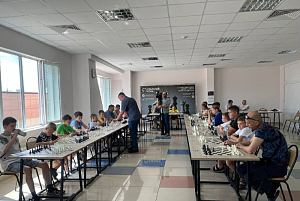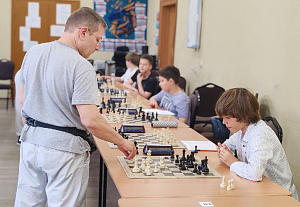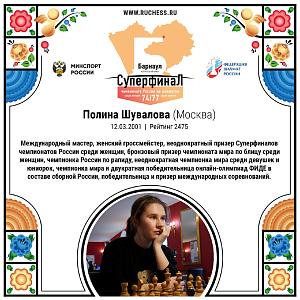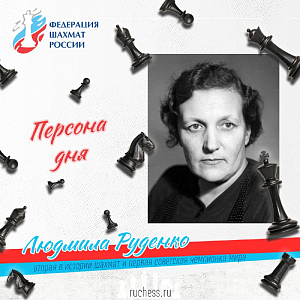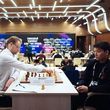8 May 2015
Stability is a sign of expertise. Or a bad shape
3rd round of Russian Club Championships in Sergei Shipov's overview.
It all depends on what exactly results are stable.
A new Russian favorite - Siberia - has the third consecutive win with a minimal score. A huge number of accidents seem to merge into large consistent pattern - the strong and skilful team always wins. Over and above, it is lucky like a first prize winner.
Look here: in a match with a quick Lada Siberians at first were standing not good, and judging by positions, should have confidently lost. It seemed that Kramnik's absence comes at a cost for the team from Novosibirsk. And then... it all got by.
Jakovenko - Bukavshin
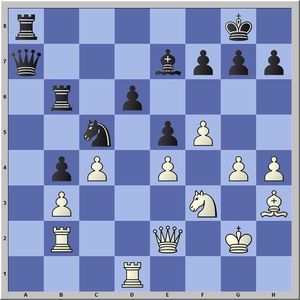
Black gained a lot. Pawns b3 and e4 are constantly weak, invasion through a-vertical is unavoidable, and White's counterattack of the king side is late. But just in case Black will play active. For some reason Ivan slowed down.
32...Qb7?!
Allowing White to rearrange the pieces successfully. Simple 32...Ra6! with the idea of Ra6-a2 made all the difference in this game. To be formal I will bring quite obvious variants: 33.g5 (bad is also 33.Qc2 Ra2 and 33.Rdd2 Ra3 34.Qe3 Nxb3!) 33...Ra2 34.Rdd2 (34.f6 Rxb2 35.Qxb2 Qa2!–+) 34...Rxb2 35.Rxb2 Qa1 36.Kh2 (36.f6 Nd3!) 36...Nxe4 37.f6 Nc3 38.Qg2 Bf8 39.h5 (or 39.Rf2 e4 40.Nd4 d5!, and bishop goes on d6) 39...e4 40.Nd4 d5! (White also has a king, with a check threat on d6) 41.Nf5 g6 42.Ne7+ Bxe7 43.fxe7 Qa7–+.
33.Re1 Ra3 34.Qc2!
Here the queen had three functions at once, controlling squares a2, b3 and e4. Jack-of-all-trades.
34...Rba6 35.Re2!
Now nothing comes on a2, it means that White holds the potential of his major pieces, which is necessary for counterattack.
35...Ra1 36.Kh2
More accurate is 36.g5 R6a3 37.h5!
36...Qa7?!
After 36...R6a3! Black could avoid complications, because 37.g5?! is answered by 37...Rxb3! 38.Rxb3 Nxb3 39.Qxb3 (39.f6 Bf8) 39...Ra3 and a take on f3.
37.g5 f6
It was not necessary (there was an alternative 37...Bd8 38.f6 g6), but also not bad.
38.Bg2
Noteworthy was 38.g6 h6 39.Ne1, and it is far from certain that Black with his weak king could break through this fortress. The thing is that he needs time to follow white queen's moves. For example, 39...R6a3 40.Bg2 Bd8 41.Qd2! Rxb3 42.Qd5+ Kh8 43.Rxb3 Nxb3 44.Qb5! etc.
38...Qa8 39.Qd2 R1a3 40.Qd1 Qe8
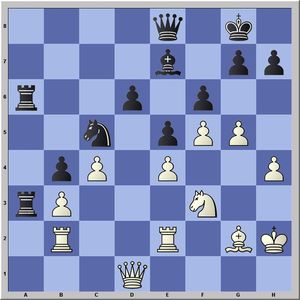
The desire to play with comfort is the basic instinct of a chess player.
41.Bh3 Kh8 42.Bg4 Ra1 43.Qc2 Rf1
Effectively stronger was 43...R6a3!?, but see previous thesis.
44.Ra2!
An unexpected turn of events. It has emerged that a-vertical is not Black's private property. It is a free public line.
44...Qa8 45.Rxa6 Qxa6 46.Qd2 Qb7 47.Qa2!
I think, somewhere here Jakovenko already started playing for win, feeling diffidence of a young opponent.
47...Bd8!
Avoiding a trap 47...Nxe4? 48.Qa4! – and White's queen comes on e8.
48.gxf6 gxf6
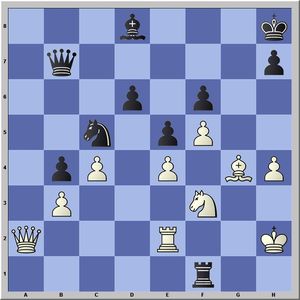
49.Bh5?!!
A bluff with a small chance of succeeding. Firm 49.Qd2 leaved White with a less good position.
Then a lot of sharp variants could be mentioned, but for Black is stronger a quiet 49...Be7! with the idea 50.Qh6 Qa8 51.Bh5 Qf8 52.Qe3 Rb1 53.Nd2 Rc1, and he starts picking weak pawns.
After 50.Qa2 Black doesn't repeat moves, he uses open space on the king side: 50...Bf8 51.Qa5 Nxb3 52.Qd8 Qg7 etc.
49...Rd1?
And bluff came off! I didn't manage to understand, what White could do against apparent 49...Nd3! with knight's relocation to f4. White suffers losses in all variants, without causing any real threats. Tricks don't work: 50.Qa4 (50.Nd2 Rc1) 50...Qe7 51.c5 (51.Rd2 Nf4 52.Bg4 h5–+) 51...Nf4! 52.cxd6 Qf8! 53.Nd2 Rc1–+.
50.Rg2!
Black king is in distress, white queen can come closer using 8th rank or g-vertical. Between two evils it is not worth choosing.
50...Rd3!
The only move here. Bad is 50...Qe7 51.Qa8 Nd7 52.Bf7!. Or 50...Rc1 51.Rg4! Qe7 52.Qd2 Ra1 53.Qd5 Qf8 54.Bf7+-.
51.Qa1!
What an exact geometry! Threats Qa1–g1.
51...Qe7 52.Qa8!
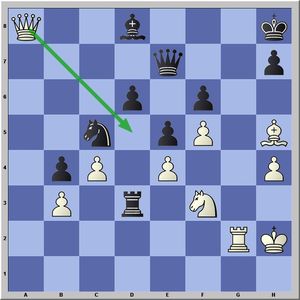
52...Nd7?
The last «Sorry!» to the team.
52...Nb7! holds a beautiful blockade idea: 53.Qc8 d5! 54.cxd5 (54.exd5? e4) 54...Nd6, with such a great knight one can already play farther.
That's why White should play slyer – 53.Nd2, after that he is ready to meet the knight on d6 playing Nd2-c4. Here Black has to change a crushing plan on an expectant one. Reaching a clear valuation of the position in the analysis is difficult. Here is only one illustrative branch: 53...Qd7 54.Qa1 Qe7 55.Qa4 Qf8 56.Qxb4 Qh6 57.Qb5 Qxh5 58.Qxb7 Qxh4+ 59.Kg1 Qh6 60.Qb8 Qe3+ 61.Kf1 Qb6 62.Qc8 Qa5 63.Qd7 Qa1+ 64.Ke2 Rxd2+ 65.Kxd2 Ba5+ 66.Ke2 Qb2+ 67.Kf3 Qxb3+ 68.Kg4 Qd1+ with perpetual check.
53.Ne1!
It has been found that Black's rook can not control d5 and simultaneous avoid knight's forced march through c2 and b4 on c6. Then followed:
53...Nb6 54.Qb8 Nd7 (54...Rxb3 55.Bf7!) 55.Qa8 Nb6 56.Qb8 Nd7 57.Qb7! Rd4 58.Nc2 Rd3 59.Ne1 Rd4 60.Nc2 Rd3 61.Nxb4! Rxb3 62.Qd5 Qf8 63.Nc6 Nc5
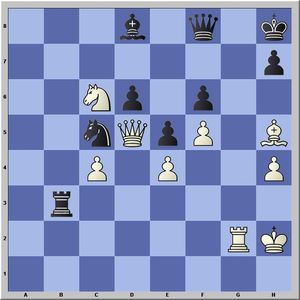
64.Qf7!
Checkmate or loss of a piece - it is all the same. Black resigned.
More obvious was change of scene on the 6th board.
Bocharov - Mokshanov

White furiously attacked the whole game, despite the large and sometimes inordinate risk. Black fought off all threats (does not implementing a couple of moments to stay with an extra pawn), passed all the obstacles, but stumbled on the last bump.
33.Ra1!
The trap looks simple. But under the time pressure and weariness even simple tasks look like a rocket science.
33...Qxa1?
At the moment many people in Samara and Togliatti probably clutched their heads.
Of course this treat should be declined. Black's move 33...Qc2! led to the equal endgame. 34.Nc6+ Kc7 35.Qxc2 Nxc2 (both rooks are under a strike) 36.Nxd8 Nxa1 37.Nxe6+ Kd6 38.Nxc5 (or 38.Nxg7 cxd4) 38...Nc2=.
34.Qb5+ Kc7 35.Qb7+ Kd6
How large is Russia, but there is no place to go.
36.Nc4!#
One response score (now I think about hockey terminology, because every day I watch reports from the World Championship in the Czech Republic) from the team from Samara could change nothing. After all, it is worth seeing.
Korobov - Predke
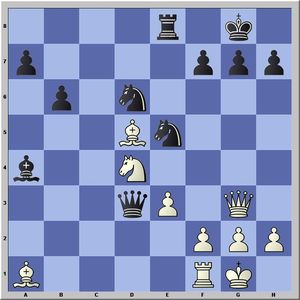
White has strong bishops, which need expanse.
29.Ne6! Ng6
Not better is 29...Qg6 30.Qxe5 fxe6 31.Ba2! with a powerful White's initiative.
30.Qxd6 Rxe6 31.Qd8+ Nf8
Here Anton made a slip. Apparently he looked only forward, having forgotten about his army's problems.
32.e4?
First the square a1 should be free for the rook after 32.Bd4!, and then by playing 32...Re8 (32...Bb5 33.Ra1!) 33.Qc7 Qf5 34.Qg3 Ng6 the bishop d5 could be strengthened: 35.e4 Qf4 36.Qc3! with the pressure on a pawn.
32...Bb5!

A nasty surprise. The first rank is too short. Like the chain armor from the famous movie.
33.Rc1
After 33.Re1 extremely strong is 33...Rxe4!. The thing is that black bishop has also defended the queen, so there is no strike on f7.
33...Qd2! 34.Rb1
On 34.Qc7 there was an interference 34...Bc6!.
34...Qd3 35.Rc1 Qd2 36.Rb1 Bc6!
That is correct. A draw with the prominent player is good. But the win is better.
37.Bb2?!
Despair. Of course, it should be made a luft by 37.h3. Then Black also did it – 37...h6!. It is not seen how White can phase out a pin along d-vertical without new losses. And Black meanwhile is planning to move forward the pawn a7.
37...Qc2! 38.Rf1 Qxb2 39.Bxe6 fxe6
And Black got a lot of extra material. The endgame is not interesting, Black won.
Now let me return to the question about stability. Malachit continues to fever. Even the arrival of Grischuk - the leader of the team - couldn't have stabilized team's play. From time to time failures happen. This time the team got into trouble because of the strongest physically player. Didn't withstand the strong hit made by a weakly opponent...
Alekseev - Khismatullin
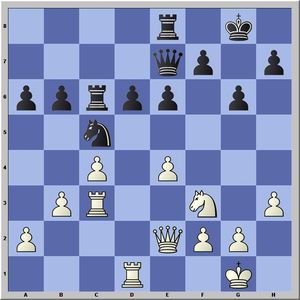
That is not the Hedgehog which admires all the aesthetes and invites aggression in all maniacs. The pawn d6 is quite weak, the knight on с5 in all variants comes under a strike b3-b4. Looking logically effort to change a structure with e6-e5 could lead to the positional clinch after Nf3-e1–c2-b4-d5.
22...Qf6?
The position was no bowl of cherries. But there is no reason to take poison.
A computer recommends consolidating by 22...Rd8. If I were Denis, I would look for a counter play on c-vertical after 22...Rec8!? 23.Rcc1 Nd7 etc.
23.e5! Qg7
It seems that only here Khismatullin has shown that after 23...dxe5 24.Nxe5 Rc7 White's attack successfully continues. 25.Rf3 Qg7 26.b4 Nb7 (26...Na4 27.Ra3!) 27.Nd7!, and the pawn b6 is lost or the white knight goes on f6.
24.b4! Nb7
Very depressing is 24...Nd7 25.Nd4 Rcc8 26.exd6+-.
25.Rcd3
A strong and competent move. But for love of the game I still show a dramatic break 25.c5!
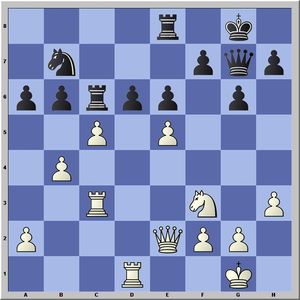
This blockade of c5 allowed White to use a black knight's bad location in full.
For example, 25...bxc5 26.b5 Rb6 27.bxa6 Nd8 (27...Na5 28.Ra3) 28.Rb3 Rxb3 29.axb3 d5 30.Qb5+-.
More beautiful is the variant 25...dxc5 26.Rd7 Nd6! 27.Qxa6 Nf5 28.g4! (can find no peace) 28...Ne7 29.b5 Rcc8 30.Rxe7+-.
25...Qf8 26.b5 axb5 27.cxb5 Rc7
After 27...Rc5 28.exd6 Rd8 29.d7 Qe7 30.Ne5 Na5 White forced new Black's weakenings with 31.Rf3! f6 32.Ng4 etc.
28.exd6 Rd7 29.Qe3!
For one passed pawn White will have two new ones.
29...Rxd6 30.Rxd6 Nxd6 31.Qxb6 Nf5 32.Ne5 Rb8 33.Qc7 Rc8 34.Qd7 Rc5

And now it's time to run to the finish line.
35.b6! Rxe5 36.b7 Kg7 37.Qc8 Rb5 38.Qxf8+ Kxf8 39.Rd8+ Ke7 40.b8Q Black resigned.
I'm sorry for repeating myself, but Ladya still plays without a success. The match with a starless Yamal (excuse me, Sashenka, but you are not a star in men's chess yet) was obviously planned as an ordinary victory. But the victory was depressed.
Ibragimov - Potapov
1.d4 f5
Since recently the Dutch Defense is in fashion again. Thanks to Nakamura and Carlsen.
2.c4 Nf6 3.Nc3 d6 4.Bg5 Nbd7 5.e3 g6 6.Nf3 Bg7 7.Bd3 c6 8.0–0
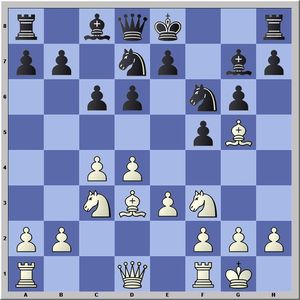
I should confess that I have never studied this variation. It's never too late to learn.
8...e5?!
A fresh novelty. Previously Black castled first.
9.e4!
A rough objection.
9...h6
This is a serious weakening of white squares. But during the game both opponents «kept silence».
Noteworthy was 9...f4, and here to the interesting complications follows 10.c5! exd4 11.cxd6! dxc3 12.e5... Let me continue this variant in the manner of XIX century: 12...0–0 (very dangerous is 12...cxb2 13.exf6 Bxf6 14.Re1+) 13.Bc4+ Kh8 14.bxc3! h6 (more persistent looks 14...Nb6 15.Bb3 Bg4) 15.exf6 Nxf6 16.Nh4! (not so clear is 16.Bxf4 Nd5) 16...hxg5 17.Nxg6+ Kh7 18.Qd3 Kh6

Showing this position from far one can suppose that Black stands good, because on 19.Ne7 there is a defense 19...Qe8!. But White has a stronger way to prepare queen's invasion on g6 – 19.Bf7!!, and this is bad for Black: 19...Ne4 (19...Rxf7 20.Ne5) 20.Nxf8 Qxf8 21.d7 Bxd7 22.Qxd7+-.
10.Bc1
Stronger is 10.Be3!, but to play so you should understand, what comes after f5-f4...
10...f4
Principal and brave opportunity. To the stable bad position followed 10...fxe4 11.Nxe4 Nxe4 12.Bxe4 Qf6 13.Be3 0–0 14.Qc2 g5 15.h3±.
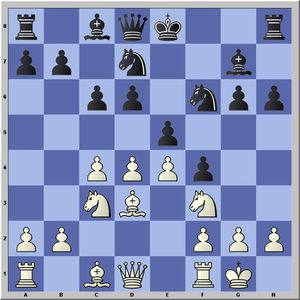
11.c5?
Amnesty. What is strong in one situation (see note to the move 9...h6), turns out to be inappropriate in the other.
White should have rough and notable fought through the center: 11.Bxf4! exf4 (on 11...exd4 there is 12.Bxd6! dxc3 13.e5±) 12.e5. What should Black do here? Of course, we don't consider knight's moves from f6. But to part with the knight is not that simple. For example, after 12...Kf7 comes 13.exd6! with the idea of c4-c5. Doesn't help also 13...c5 14.b4! cxd4 15.c5! dxc3 16.Qb3+ Kf8 17.Bxg6 with another final in Morphy style.
The most persistent is 12...0–0, but it doesn't solve the problems too: 13.exf6 Qxf6 14.Ne4 Qe7 15.Re1 Nf6 16.Ned2! Qf7 17.c5!, and white knight longs for e5.
11...dxc5 12.dxe5
If we speak about white squares, more interesting is 12.d5!
12...Nh5
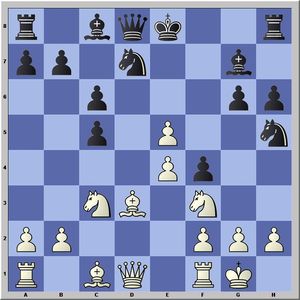
And Black has consolidated the center.
Let's jump the middle of the game...
13.Be2 Qe7 14.Ne1 Nxe5 15.Bxh5 gxh5 16.Qxh5+ Kf8 17.Qe2 Qf6 18.f3 Be6 19.Qf2 c4 20.Ne2 Ng6 21.Nc2 Kf7 22.Ncd4 Bd7 23.Rd1 Rhd8 24.Bd2 c5 25.Nf5 Bxf5 26.Bc3 Ne5 27.exf5 Qxf5 28.Rxd8 Rxd8 29.Qh4 Rg8 30.Kh1 Nd3 31.Bxg7 Rxg7 32.Nc3
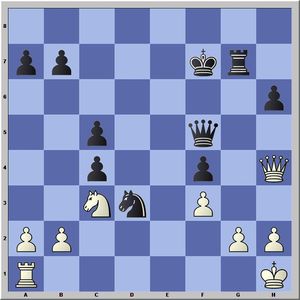
The end became the tragedy of one move. He wasn't able to put a knight on e4.
32...Qg6! 33.Rg1 Qg5!
And a smother mate is unavoidable. White resigned.
Yandemirov's win against Sergeyev just helped to flatten a situation in the match. A sensational defeat could happen if Goryachkina managed to employ an extra-player... a normal extra-pawn in the game against Timofeev. She lacked a little - self-confidence. Soon she will realize that the devil is not so black as his rating. Then she will start crushing us!
In the end I would like to tell about the main match of the day.
Petersburg against Moscow - it is always interesting. In any sport. I was strongly impressed by the KHL semifinal playoff matches between army clubs of two capitals...
But let's leave this history on another occasion. In the chess match Peter won again! Here everything was about players' accuracy in using their opportunities. And its absence.
One of the best players of the New World proved to be stronger than the Old World champion.
Dominguez - Najer

Leinier was shattering Black's defense step-by-step. Zhenia was obliged to play g6-g5 to avoid a checkmate. As a result, his pawn structure became weak.
57.g4! fxg4
Strengthening of the fence doesn't work: 57...g6 58.Qg8+ Kh6 59.Rd7 – it is a checkmate again.
58.Qxe4+ g6 59.Rd7+ Kh6 60.hxg4 Rc1 61.Qb7 Qh8
I don't add a question mark here. Apparently Zhenya understood well that the rook endgame after 61...Qc6+ 62.Qxc6 Rxc6
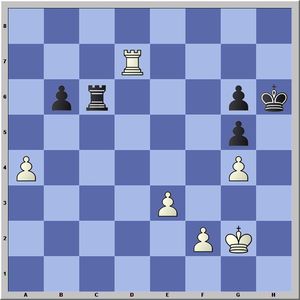
is hopeless. The thing is that White has no reason to confine the black king, risking to miss some stalemate combination. He keeps the pawn a4 unexchanged and moves his king forward: 63.Rd4! Kg7 64.Rb4 Kf7 65.Kf3 Ke6 66.Ke4 Kd6 67.Kd4 Kd7 (67...Kc7 68.Rc4) 68.Rb5!, and then eats up Black's king side.
In the game happened something that could not be avoided:
62.Qf3! And Black resigned due to the mate on h-vertical.
On the last board Moscow could take it out. But its player was be too cautious.
Potkin - Saric

White's passing pawn on the edge at some point should reach a8. That's why there is only one question: how to neutralize Black's counter play related to the queen's invasion.
35.Ne3?
Incorrect solution. White should have avoided early exchanges. And not only defending, but also attacking: 35.Bd3! Bc1 36.Qe6! (in a variant 36.a4 Qh6 37.b4 Qd2+ 38.Kf1 e4! 39.Bxe4 Bb2 Black got a mighty compensation for pawns) 36...Qg5 (after 36...Qh6 37.Qe7+ Kh8 38.Qd8+ Ng8 39.Qh4! White exchanged the most dangerous Black's piece) 37.Kf1! Bb2 (or 37...Qh5 38.a4!) 38.Qe7+ Kg8 39.Qd8+ Kg7 40.Qxc7+ Kg8 41.Qc8+ Kg7 42.Qf5! etc. I think, Black couldn't rescue.
35...Nxe4! 36.Qxe4 Bxe3! 37.Kxe3 Kf6
Now queen's invasion threats again. Here comes an unexpected motive...
38.Kf2 Qg5 39.Ke2 Qc1! 40.Qxg4 Qc2+ 41.Kf1 Qb1+ 42.Kf2 Qxa2+ 43.Kg1 Qb1+ 44.Kh2
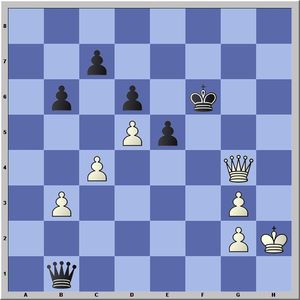
44...Qf5!
Without a pawn on a2 the pawn endgame is dangerous only for White.
45.Qh4+ Kg6 46.g4 Qf4+ 47.Kh3 Qe3+ 48.g3 Qc1 49.Qh5+ Kg7 50.Kg2 Qd2+ 51.Kh3 Qc1 52.Kg2 Qd2+ 53.Kh3 Qc1 54.Kg2 Draw.
This unfortunate omission was fatal for Moscow. There seems that it has lost all the chances of gold medals.
For afters I'll show you an amazing horror film from the same match.
Dubov - Matlakov
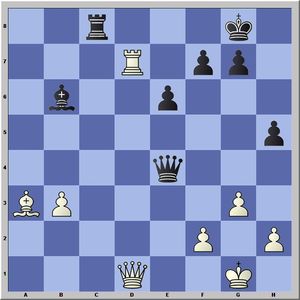
Black's initiative is quite dangerous. Square f2 falls apart, also threats h5-h4-h3.
34.Rxf7!?
A nice strike! From the analytical point of view, it loses, but the practical meaning was huge.
In reality there was no reason to use nuclear weapon. The ordinary Suvorov's bayonet could save White: 34.Rd6!. It is not only an effort to distract the bishop b6 from f2, but also a securing of d8 for rooks' exchange. For instance, 34...Ba7 35.Rd7! Ra8 36.Bb2 e5 (or 36...h4? 37.Rd8+ Rxd8 38.Qxd8+ Kh7 39.Qxh4+) 37.Rd8+ Rxd8 38.Qxd8+ Kh7 39.Qd1 with equal endgame.
After 34...Qb7 35.Bb2 White made counter threats on the king side. So 35...h4 didn't work because of 36.Qg4.
Perhaps, it shouldn't be analyzed, but 34.Qxh5? (see a position on the diagram) was not good over the strike 34...Bxf2+! with the quick mate for White: 35.Kf1 Qh1+ 36.Kxf2 Rc2+ etc.
34...Kxf7 35.Qd7+
Here Maxim had to choose: where should the king go? I am sure, he would have come to the right decision during the blitz game. But in classical one he played too sly.
35...Kf6?
Apparently, the idea was to set free g7 pawn in a variant 36.Qxc8 Qe1+ 37.Kg2 Qxf2+ 38.Kh3 Qf1+ 39.Kh4 – 39...g5+! 40.Kxh5 Qh3#. Meanwhile, winning was a provoking move 35...Kg6!, because after
36.Qxc8 Qe1+ 37.Kg2 Qxf2+ 38.Kh3
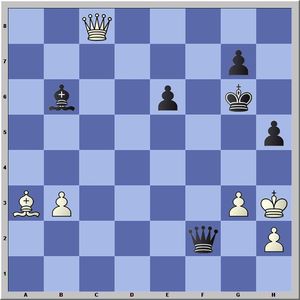
White's king is in danger. Here began the second stage of attack: 38...Qf5+ 39.Kg2 h4!, and a threat h4-h3+ turned out to be killing. And 40.gxh4 was answered with the mate – 40...Qf2+ 41.Kh3 Qf3#. 40.Qe8+ Kh7 doesn't change anything.
36.Bb2+! e5 37.Qd6+!
A new fine point. In a variant 37.Qxc8 Qe1+ 38.Kg2 Qxf2+ 39.Kh3 Qf1+ 40.Kh4 g5+ 41.Kxh5 White's queen controlled a square h3, but troubles comes from another direction: 41...Qe2+! 42.Kh6 Qxh2+.
37...Kf7
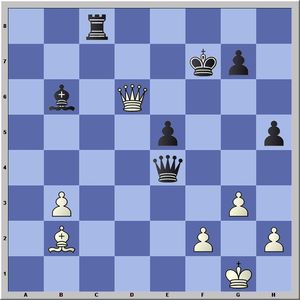
38.Qd7+!
The take 38.Qxb6? is early now over 38...Rc2 39.Ba3 Re2 40.Bb4 Rb2!, and Black's rook enter the first row.
38...Kf6
With the king on g6 White can eat up the rook: 38...Kg6 39.Qxc8 Qe1+ 40.Kg2 Qxf2+ 41.Kh3 – his king couldn't be reached any more, and a queens endgame after 41...Qxb2 42.Qe6+ Kh7 43.Qxb6 is drawish.
39.Qd6+ Kg5! 40.Qxb6! h4
To the perpetual check leads 40...Rc2 41.Qd8+ Kg6 (41...Kf5 42.Qd7+) 42.Qe8+ Kh6 43.Qh8+.
41.Qe6!
Again the only, but enough for rescue manoeuvre.
41...Qe1+
Allow me to bring the old stock phrase of commentators. For Black it was not late to lose: 41...Qf5? 42.f4+! exf4 43.gxh4+ Kg4 44.h3+, and he lost a queen.
Ineffective at all is 41...hxg3 42.hxg3 Qf5 43.Qxe5=.
42.Kg2 h3+
Maxim ingeniously seeks chances to win.
43.Qxh3 (43.Kxh3? Qf1#) 43...Qe4+ 44.Kg1 Rc2

But Danya didn't fail too.
45.f4+!
Covering of the 4th horizontal allows White to mind the checks again.
45...exf4 46.Qh4+ Kg6 47.Qg4+ Kf7 48.Qd7+ Kf8 49.Qd8+
From the standpoint of «Show must go on!» one can play 49.Qxg7+ Ke8 50.Qe5+ Qxe5 51.Bxe5 f3, but here there is also a draw.
49...Kf7 50.Qd7+
In this very moment going on a show was impossible: 50...Kg8? 51.Qxg7#.
50...Kf8!
And the opponents peacefully shook hands. It was a great chase!
In the women's championship the match between the favorite teams Moscow and Ugra was thrust into the spotlight. The strongest players turned the beam.
Gunina - Pogonina
Actually, in this game the opposition of titles is not so obvious. Valya already achieved a lot in chess, but she didn't reach the final of Individual Women's World Championship...
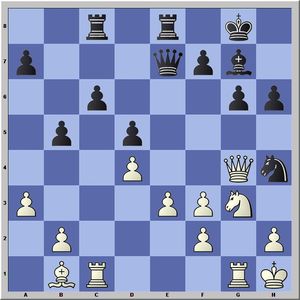
When Valya aimed to attack, she is impossible to stop. And the risk of losing material without compensation is not an obstacle for her... Especially in the cases where compensation is detected.
28.Nh5! f5 29.Qf4 Rf8?
Psychological moment. Natalia believed her cruel opponent, being defeated without a counter play.
The main variant of White's combination was worse checking. I am sure that Gunina with all her talent could not have calculated all the lines to the end. So, let's see: 29...gxh5! 30.Qxh6 Kf8! (White's attack just promoted 30...Nxf3 31.Rg2 Kf8 32.Qxh5 Nd2 33.Bxf5 Rc7 34.Rcg1+-) 31.Qxh5 Bf6!. And what comes next? Threats Qe7-f7, after which comes the shift of power.
I am sure, Gunina saw a break 32.e4! from far.
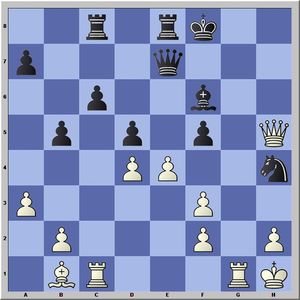
From the practical point of view it is not enough. It is clear that White has a strong initiative.
Here the computer insists that after 32...Rc7! Black can step-by-step repel an attack, having a piece for many pawns. But from the human's point of view the knight's return with the following complicated opposite-colored bishops endgame looks reasoned: 32...Nxf3! 33.Qxf3 fxe4 34.Qe3 Qd6 35.f3 Ke7 36.fxe4 dxe4 37.Bxe4 Bxd4 38.Qg5+ Qf6 with a good drawish chances for Black. But if didn't happen.
30.Nxg7 Kxg7 31.Rg3 Kh7 32.Rh3! g5 33.Qg3
Here the defense from f3-f4 is not seen.
33...c5
Or 33...Ng6 34.Rg1 Kg7 35.f4! g4 36.Rh5 Qe6 37.h3+-
34.dxc5 Rxc5 35.Rg1!
All forces - to the front.
35...Qc7 36.f4 Rc1 37.fxg5 Qxg3 38.hxg3 Rxg1+ 39.Kxg1 Nf3+ 40.Kg2 Nxg5 41.Rh1
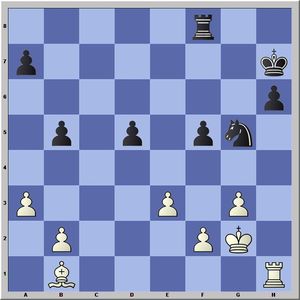
A result of complications was the endgame with N-weak pawns for Black. Then followed:
41...Kg6 42.g4 Ne4 43.gxf5+ Kg5 44.f3 Nd2 45.Bd3 Nc4 46.f4+ Kg4 47.Kf2 Nxb2 48.Rg1+ Kh4 49.Be2 Black resigned.
The second strike at Ugra looked so.
Kovalevskaya - Guseva
In this pair the inequality in authority and merits was clear. Perhaps this came into play here.
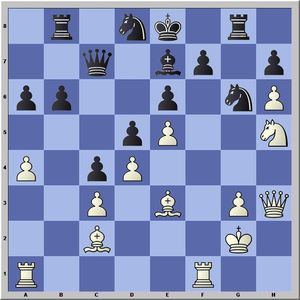
The fence made of black pawns only seems firm.
28.Ng7+ Kd7 29.Rxf7!
Such a shell can destroy any wall.
29...Nxf7 30.Qxe6+ Kd8 31.Qxf7 Rf8 32.Ne6+ Kd7 33.Nxf8+ Rxf8 34.Qxd5+ Kc8 35.Bxg6 hxg6 36.Rf1! Black resigned.
As a result Moscow won 3-1 having mighty improved its medal chances.
The tournament suddenly comes to its middle. The high point is ahead.














